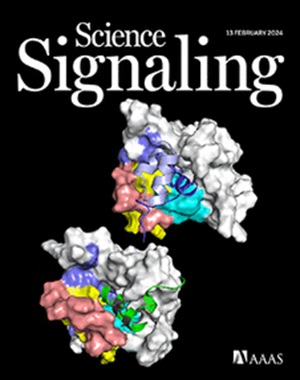MAPK and mTORC1 signaling converge to drive cyclin D1 protein production to enable cell cycle reentry in melanoma persister cells
IF 6.6
1区 生物学
Q1 BIOCHEMISTRY & MOLECULAR BIOLOGY
引用次数: 0
Abstract
In BRAF-mutant melanoma cells treated with inhibitors of the kinases BRAF and MEK, a subset of cells rapidly and nongenetically adapts to escape drug-induced quiescence and reenters the cell cycle. Here, we investigated the mechanisms enabling this drug escape by computationally reconstructing single-cell lineages from time-lapse imaging data, linking dynamic signaling pathways to distinct cell-cycle fate outcomes. We found that reactivation of the MEK substrate ERK was necessary but not sufficient to drive escape; rather, the activity of the protein complex mTORC1 was also required to promote cell growth and protein synthesis in drug-treated cells destined for cell-cycle reentry. ERK and mTORC1 signaling converged to increase the abundance of cyclin D1 protein, a critical bottleneck for cell-cycle commitment under drug pressure. In cells in which endogenous cyclin D1 was fluorescently tagged using CRISPR, the subset that escaped drug treatment exhibited marked accumulation of cyclin D1 at least 15 hours before cell-cycle reentry, enabling early prediction of future drug escape. Cyclin D1 thus represents both an early biomarker and potential therapeutic target for suppressing drug escape in melanoma. We observed a similar mTORC1-driven mechanism underlying escape in lung cancer cells, but not colon cancer cells, highlighting partial generalizability across cancer types.
MAPK和mTORC1信号汇聚驱动细胞周期蛋白D1蛋白的产生,从而使黑色素瘤持续细胞重新进入细胞周期
在BRAF突变的黑色素瘤细胞中,用BRAF和MEK激酶抑制剂治疗,细胞亚群迅速和非遗传性地适应逃避药物诱导的静止并重新进入细胞周期。在这里,我们通过计算重建单细胞谱系,从延时成像数据中研究了这种药物逃逸的机制,将动态信号通路与不同的细胞周期命运结果联系起来。我们发现MEK底物ERK的再激活是必要的,但不足以驱动逃逸;相反,蛋白质复合物mTORC1的活性也需要促进细胞生长和蛋白质合成的药物处理细胞的细胞周期返回。ERK和mTORC1信号融合增加了cyclin D1蛋白的丰度,这是药物压力下细胞周期承诺的关键瓶颈。在使用CRISPR荧光标记内源性细胞周期蛋白D1的细胞中,逃避药物治疗的细胞亚群在细胞周期再进入前至少15小时表现出明显的细胞周期蛋白D1积累,从而能够早期预测未来的药物逃逸。因此,Cyclin D1既是早期生物标志物,也是抑制黑色素瘤药物逃逸的潜在治疗靶点。我们在肺癌细胞中观察到类似的mtorc1驱动的逃逸机制,但在结肠癌细胞中却没有,这突出了癌症类型的部分普遍性。
本文章由计算机程序翻译,如有差异,请以英文原文为准。
求助全文
约1分钟内获得全文
求助全文
来源期刊

Science Signaling
BIOCHEMISTRY & MOLECULAR BIOLOGY-CELL BIOLOGY
CiteScore
9.50
自引率
0.00%
发文量
148
审稿时长
3-8 weeks
期刊介绍:
"Science Signaling" is a reputable, peer-reviewed journal dedicated to the exploration of cell communication mechanisms, offering a comprehensive view of the intricate processes that govern cellular regulation. This journal, published weekly online by the American Association for the Advancement of Science (AAAS), is a go-to resource for the latest research in cell signaling and its various facets.
The journal's scope encompasses a broad range of topics, including the study of signaling networks, synthetic biology, systems biology, and the application of these findings in drug discovery. It also delves into the computational and modeling aspects of regulatory pathways, providing insights into how cells communicate and respond to their environment.
In addition to publishing full-length articles that report on groundbreaking research, "Science Signaling" also features reviews that synthesize current knowledge in the field, focus articles that highlight specific areas of interest, and editor-written highlights that draw attention to particularly significant studies. This mix of content ensures that the journal serves as a valuable resource for both researchers and professionals looking to stay abreast of the latest advancements in cell communication science.
 求助内容:
求助内容: 应助结果提醒方式:
应助结果提醒方式:


